You may have noticed that the fighting games I’ve looked
over thus far have all been from Japan . The truth is, Japan has the heaviest focus in
making fighting games nowadays. There
have been a few more western-made fighting games in recent years, like the new
Killer Instinct and Skullgirls, but the only western fighting game franchise
that has managed to stick around consistently is one of the first: Mortal
Kombat.
Mortal Kombat is defined in the public consciousness by its most distinguishing and (mostly) consistent element: violence. Unlike the flashy hit effects of most Japanese fighting games, Mortal Kombat has always made every punch and cut make blood fly from the player on the receiving end with meatier sound effects. Equally as famous are the series’ gory finishing moves, the fatalities, in which the designers wracked their brains to come up with as many outlandish ways to destroy a fleshy body as they could.
But there’s more to this franchise than the
violence (I don't think any franchise with a camp could be that shallow). The
combat plays into the violence, and the games are known by its fans for
having more of a story to it that I find a surprising number of people outside
of Kamp Kombat are quite knowledgeable of.
It probably helps that unlike other fighting games like
Street Fighter or KOF, Mortal Kombat has always had the story in the games
themselves instead of relying on a manual or online text page to tell players
what’s going on.
With nine different games in the main series plus a tenth on
the way, the story of Mortal Kombat is a long one with conflicts and underlying
themes that sometimes seem to go beyond simply having a villain be evil and
bringing in heroes to stop them, even if that is the most basic summarization
of each game. As for the more detailed
summarization…
Story
Mortal Kombat takes place in a multiverse of many different
worlds, referred to as “realms.” Each realm
inhabits different people, races and terraformations, and are all given gods to
oversee and protect them. Though these gods keep
watch over their assigned realm, Mortal Kombat’s entire universe is overseen by
a higher power known as the Elder Gods.
The Elder Gods watch events from a higher plane of existence, but don’t
interfere unless something happens to threaten their existence or break an
explicit rule they set in place.
There are a handful of different recurring realms shown in the Mortal
Kombat franchise, but the ones of focus are Earthrealm and Outworld. Earthrealm is a realm very much like our own,
while Outworld is an otherworldly realm full of monsters, magic, and demons.
The first three Mortal Kombat games revolve around conflicts
between Earthrealm and Outworld, starting with the titular Mortal Kombat
tournament.
Outworld has the ability to merge other realms with itself,
which its evil emperor Shao Kahn uses to make the other realms into his own
territory and conquer them. In order to
give other realms a fighting chance and prevent Outworld from merging with
everything willy nilly, the Elder Gods made a rule that Outworld can only
invade/assimilate a realm by having a team representing them defeat a team
representing the targeted realm in a tournament called Mortal Kombat. Originally in the story you only had to win
once, but it was later retconned to Outworld having to win 10 times in a row.
The tournament in the first game is the last one Outworld
needs to start the merging, so it’s quite upsetting to Shao Kahn that they lose in the end
when the hero Liu Kang defeats their Outworld champion Goro and Kahn’s right-hand sorcerer Shang Tsung.
Or at least, that's what happens in that game now. Originally the Mortal Kombat tournament in the first game was a shaolin martial arts tournament that was corrupted by its evil grandmaster Shang Tsung. Outworld didn't even have anything to do with it originally, and some of the characters were characterized differently. It only has the plot we know today because it's been retconned to hell and back.
In the second game, Shao Kahn challenges
Earthrealm to one more Mortal Kombat tournament held in Outworld as a winner-take-all
competition. When that doesn’t work, he
finds a way around the rules and invades Earthrealm anyway in the third game.
Every MK game after that until the most recent one has less
to do with defending Earthrealm from Outworld and more to do with defending
both worlds from varying evils up until one last gigantic clash in
Mortal Kombat: Armageddon. Try to guess
what happens in Mortal Kombat: Armageddon.
The games after 3 are also where the story gets complicated. The plot of the first three Mortal Kombat games are
straightforward and simple enough, kind of like KOF, but after the initial trilogy is when the plot starts taking some twists and turns.
In Mortal Kombat 4, the fallen elder god Shinnok and his own
right hand sorcerer Quan Chi start their own invasion of the realms with an
army of evil built in their own realm, the Netherrealm.
In Mortal Kombat: Deadly Alliance , Shang Tsung and Quan Chi team up to
kill Liu Kang and (supposedly) Shao Kahn in their preparation to invade the realms by
resurrecting the invincible mummified army of the Dragon King, the previous ruler
of Outworld before Shao Kahn.
In Mortal Kombat: Deception, the Dragon King himself, Onaga,
comes back to take control of his army and try his hand at invading after
having tricked a man named Shujinko into gathering a bunch of artifacts of
power called the Kamidogu to resurrect him.
In Mortal Kombat: Armageddon, almost every character from
every Mortal Kombat game gathers in one large area for a gigantic battle. All of them are informed that the last one standing will be able to claim the prize of
ultimate power by killing the fire elemental named Blaze at the top of the
gigantic pyramid that rises from the ground.
The most recent Mortal Kombat on the HD systems, known as
Mortal Kombat 9, takes place in an alternate timeline in which Earthrealm’s
thunder god Raiden attempts to prevent the Armageddon he (somehow) sees in the
previous timeline through a connection to his amulet. The result is a similar basic plotline to the
original three games, but with retcons and changes made in Raiden’s attempts to
change the future and prevent the Armageddon.
It’s much like the recent Star Trek movies, in that sense.
 |
| "I must prevent this from happening. What is the most clear and straightforward message I can send to my past self? |
As I stated, Mortal Kombat can get kind of
complicated, and the retcons and inconsistent endings scattered throughout
don’t help. It’s a good story if you take the effort to look into it though.
After all, a clash of good heroes and villains practically writes
itself.
The Heroes
Please note that
unless stated otherwise, the following descriptions refer to the games before
Mortal Kombat 9’s alternate timeline.
Character roles and events of the first 3 games 9 recreates are, for the
most part, the same, but with more character deaths and slight alterations.
Mortal Kombat has had many characters that could be
classified as heroes, but only a few of them have the distinction of
consistently acting as one for the franchise’s entire run.
The most important of them is the aforementioned god of Earthrealm, Raiden.
No.
No.
Yes.
Raiden is the thunder god that oversees Earthrealm. Being immortal, he has never aged and his powers have aided Earthrealm’s heroes many times. He usually acts as the wise mentor to the
people of his realm, since gods like him can’t interfere with their own realm
unless it’s threatened, but since that happens a lot he gets the opportunity to
kick a lot of ass. Raiden is so dedicated
to Earthrealm’s protection that he gives up his status as an Elder God, after his promotion in Mortal Kombat 4, in order
to go back to Earthrealm and help beat the Deadly Alliance. Sadly, the alliance gets the better of him
and he dies, but being a god, Raiden is reborn in a more vengeful, darker form,
furious with how humans had messed up Earthrealm. He still fights evil in this form, but is
more bitter and less forgiving of mistakes on the part of Earthrealm residents.
But if it’s not Raiden saving the world, it’s usually Liu
Kang, Earthrealm’s greatest warrior. Liu Kang, along with his razor hat-wearing
best friend Kung Lao, is an ass-kicking monk of the Shaolin recruited by Raiden
for his fighting prowess and good heart. He brutalizes people just like
everyone else, but only for the ones that are asking for it, kind of like
Kenshiro.
As mentioned before, Liu is the ultimate victor and hero of
the first four Mortal Kombat games, defeating Shang Tsung, Shao Kahn and Shinnok until the Deadly Alliance
got the drop on him, but even after that he fights back from the grave. After his death and
rebirth, the reborn Raiden brings Liu back as a zombie, retaining his combat
abilities, but lacking his soul and conscience, making him a mindless fighting machine.
Kung Lao shares many
of Liu Kang’s values. He wasn’t in the
first game because he doesn’t advocate violence, but after their Shaolin temple
was attacked by Outworlders, he deemed it a necessary evil and entered Outworld’s tournament in
the second game.
 |
| "For the Shaolin!" |
His impressive combat abilities can at least partially be
contributed to him being a descendant of a warrior monk with the same name who
previously defended Earthrealm until he was killed by Goro. Kung Lao likely trained himself in combat
specifically to defeat Goro and avenge his ancestor. I thought revenge is against a monk’s
teachings, but at the end of Mortal Kombat 4’s updated version, he makes peace
with Goro anyway, so I guess after that it’s all good. That is, until he goes to fight the Deadly
Alliance to avenge Liu, abandoning his pacifist ways and training with
Liu’s former master Bo Rai Cho, who also fights the Deadly Alliance.
The other primary heroes of Earthrealm have acted more on
their own, again like Chun Li and Guile of Street Fighter’s story or the Ikari
Warriors of KOF. In Mortal Kombat’s
story, the special forces team is referred to as the United States Special Forces, but
is later reformed into the Outer World Investigation Agency after Shao Kahn’s
invasion of Earthrealm in Mortal Kombat 3.
Who exactly was in charge of this organization before it
became the OWIA is never made clear, but the two most prominent members
throughout the series are Sonya Blade and Jackson
“Jax” Briggs, the leader after the forces’ reformation. Both of them are very protective of each
other.
Sonya enters the first Mortal Kombat tournament in pursuit
of Kano , the
leader of a criminal organization of arms dealers called the Black Dragon, as well as the one who killed Sonya's former partner.
 |
| He got that plate from a fight with Jax. |
Unfortunately, Sonya’s mission didn’t have its conclusion,
as both of them were kidnapped by Shao Kahn in the second game. You can even see them chained up in the
background of the final stage.
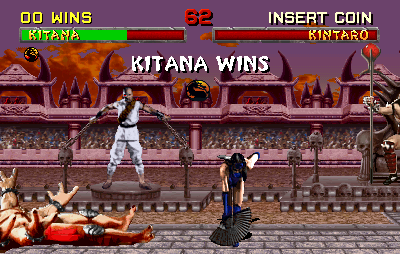 |
| Too bad you can't attack background characters. |
With them out of commission, Jax takes over for Sonya in the
second game and later gets bionic arms for the third to whup even more evil
butt.
 |
| Someone gon' get dey ass kicked. |
It's strange that he felt the need to have those cyborg arms when nobody else from Earthrealm ever did. He lost his arms in the new timeline, but in the first one he was probably fine without them. Outworld and Earthrealm warriors seem to be pretty equal in terms of power potential. In fact, one of the heroes is from Outworld, and initially serves Shao Kahn: Princess Kitana.
Kitana is the former princess of Edenia, one of the many realms that Outworld
consumed and Shao Kahn took over. When
Shao Kahn forcefully married Edenia’s queen Sindel, Kitana became his stepdaughter,
unbeknownst to her.
After Shao Kahn reveals to Kitana her true origins, she
joins the forces of Earthrealm to take back Edenia from Shao Kahn and prevent
him from ever rising to power again.
Being one who has been by her stepfather’s side, her knowledge of
Outworld makes her a big help, as does her deadly bladed combat fans.
Romantic interest in Liu Kang is heavily implied, especially
at the end of Mortal Kombat 4 when Kitana offers him to rule Edenia by her
side. His answer is no, but I don’t think
that would’ve worked out had Liu accepted anyway, considering Edenians age far
far slower than people from Earthrealm.
Kitana is at least 10,000 years old! She's a little old for him.
There are a couple of characters in later games that have
been labeled as heroes in their respective games because they star in
each one’s single player story called Konquest mode. In Mortal Kombat Deception, the story
revolves around Shujinko unwittingly gathering
the Kamidogu to allow for the Dragon King to be
resurrected, setting the events of the game in motion.
In Mortal Kombat Armageddon: A young man named Taven awakens
from a century’s sleep so that he can fight his brother to determine in what
way Armageddon will be prevented after defeating Blaze.
I don’t consider these two to be heroes of the story,
however, because even though they have stories dedicated to them, they hardly
matter to the main plots at hand. Taven's actions end up being mostly irrelevant because neither he nor his brother end up killing Blaze, and all Shujinko does is set up the main conflict. They’re
side characters, not the focus.
The heroes that have continued to consistently fight long
after Earthrealm’s invasion take the center stage, but throughout the franchise
there have been many more minor heroes to back them up. These include Kitana’s childhood friend Jade,
former Black Dragon fighter Kabal (for a while, at least), magical Native
American Nightwolf and groin-punching martial arts action movie star Johnny
Cage. Everyone loves Johnny.
The famous cryomancer Sub-Zero has also fought for the side
of good throughout the franchise, but the sub-plot regarding his identity and
assassin clan is so detailed it needs its own section.
The Lin Kuei Kerfuffles
Like KOF’s Hizoku and Guilty Gear’s Assassin’s Guild,
Mortal Kombat has an organization of supernatural assassins, the Lin Kuei.
The first Lin Kuei assassin seen in the franchise is the
infamous Sub-Zero, or rather, the first one, seen in the very first Mortal
Kombat and its prequel Mortal Kombat Mythologies.
I’m noticing a pattern here.
Assassins are supposed to be good at swiftly killing their targets
without anyone (sometimes including the target) knowing. I thought for that kind of stealth you’d want
to wear something harder to spot, like black suits or camouflage, and have a
way to kill them in one motion.
But no, according to fighting games assassins wear bright
blue jammies and flowing robes, and beat up targets with ice powers and
elaborate billiard balls of death.
The closest character in these games to an actual assassin
is Lin in KOF. He dresses partially in
yellow, but his clothes are tight so as not to get in the way, he moves
superhumanly fast, attacks with piercing jabs that could quickly kill any
normal person with precision, and even produces his own poison. I think I'll spend my assassination budget on him. Him or that fellow with the bar code on his head.
But I digress.
In Mortal Kombat Mythologies: Sub-Zero, the first Sub-Zero (named Bi-Han) was tricked into helping Quan Chi revive his god Shinnok using Shinnok’s
mystical amulet, which in the end Sub-Zero took back to relinquish Shinnok of
his power.
 |
| Doesn't really fit the outfit. |
Later Bi-Han is hired by Shang Tsung to
represent Outworld in the Mortal Kombat tournament. There, he's killed by another participant:
Scorpion, a vengeful hell spawn from an elite ninja clan called the Shirai Ryu. Scorpion has an especially big problem with Sub-Zero. For one, Sub-Zero killed him during a mission in which they both needed to get the same mystical scroll. If that weren't enough, Scorpion believes Sub-Zero killed off the rest of the Shirai Ryu as well, but Sub-Zero had no part in that one. Quan Chi was the one who really did it.
After dying, Bi-Han is brought back to life not
unlike Scorpion. With his soul corrupted
by violence, he becomes the pitch-black wraith Noob Saibot (whose name comes
from spelling the last names of Mortal Kombat’s creators backwards for some
reason).
Believe it or not, for the longest time, Noob Saibot being the elder Sub-Zero was only very strongly hinted at by the creators. It was never outright stated until Mortal Kombat Deception. So what is now common knowledge was originally pure speculation.
Believe it or not, for the longest time, Noob Saibot being the elder Sub-Zero was only very strongly hinted at by the creators. It was never outright stated until Mortal Kombat Deception. So what is now common knowledge was originally pure speculation.
Noob Saibot’s alliance since he became the wraith we know
him as today is ever-shifting, but consistently he always looks after his own
interests, which often means helping the villains.
After Bi-Han’s transformation, his younger
brother Kuai Liang takes the mantle in order to get revenge on Scorpion and became the
second Sub-Zero that has appeared in every game since.
When he realizes this one isn’t the same as the one he killed,
Scorpion makes a nonviolence vow for the Kuai Liang (originally it was a
vow of protection, but they retconned that).
With his vengeance settled on that end, Scorpion finds out about Quan
Chi being the one he’s really after in Mortal Kombat 4 and goes after him in
Deadly Alliance, after which he had to be saved by the elder gods and fight
Onaga for them in Deception.
But Sub-Zero’s troubles don’t end with Scorpion’s leave. After Mortal Kombat 2, the Lin Kuei start a
new project called the Cyber Initiative, in which they make their members
undergo highly advanced cybernetic transformations, basically turning them in
to cold, emotionless killing machines.
Knowing that cybernetics eat your soul, Kuai Liang leaves the Lin Kuei,
who retaliate by sending products of the cyber initiative out to kill him:
Cyrax, Sektor and Smoke.
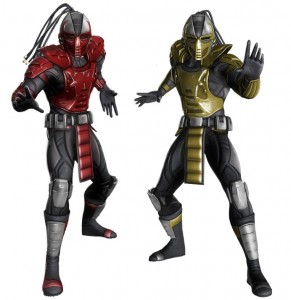 |
| Sektor and Cyrax |
Cyrax and Sektor willingly allowed themselves to become what
they are, but not Smoke. Smoke opposed
the cyber initiative with Kuai, but was caught and forced into his new
metal body, in which he’s forced to hunt his former friend. Much
later Smoke is reprogrammed by Noob Saibot to form a dual tag team boss in Mortal
Kombat: Deception.
In the alternate timeline of Mortal Kombat 9, things go
quite differently for Smoke and Sub-Zero.
In the new timeline, Raiden saves Smoke from being captured after his
future vision shows what Smoke would become if he were. Instead, Kuai Liang is later captured and
transformed in his place, creating Cyber Sub-Zero, who follows his programming
like the other cyborgs until a certain point when he’s given free reign and fights on
the side of good again.
In the original timeline, Kuai Liang instead rises to the top
and takes over the Lin Kuei to make it right.
While in his position of power, he raises an apprentice named Frost, who it turns out wants to get strong enough to kill her master and take his
place. That does not go well for her.
As for Sektor and Cyrax, they go in completely opposite
directions after Mortal Kombat 3, metaphorically speaking. Cyrax joins Sonya and Jax after they assist
him in recovering his humanity, while Sektor remains a remorseless machine and
makes his own cyber ninja clan called the Tekunin.
Mortal Kombat 9’s alternate timeline suggests that this is
partially because of who they were before becoming cyborgs. In the new timeline, a human Cyrax and Sektor enter
the first Mortal Kombat. Both of them
use the same weapons they would later have built into them, but they have
opposing views toward the Lin Kuei’s cyber initiative. Cyrax believes the human soul and instinct is
essential, while Sektor believes becoming cyborgs will make them more efficient
and powerful. Cyrax ends up trying to
leave the Lin Kuei to get out of it, but is caught and turned into the cyborg
we better know him as.
This explains why in the original timeline Cyrax was able to
get his humanity back and not Sektor: Cyrax always wanted it.
The Lin Kuei aren't the villains of Mortal Kombat, but they definitely add to the conflict. Since they're only doing their job, you could say a lot of them stand in a morally gray area, unlike the actual antagonists, who are so evil they practically sit on thrones of skulls. Keep
posted for part 2, where I will go into detail on the many villains of the
Mortal Kombat mythos.
Special thanks goes out to ScrewAttack's Patrick Breeden, the biggest MK fan I know, for taking the time to look over this for accuracy. You can find his personal website here.
Special thanks goes out to ScrewAttack's Patrick Breeden, the biggest MK fan I know, for taking the time to look over this for accuracy. You can find his personal website here.



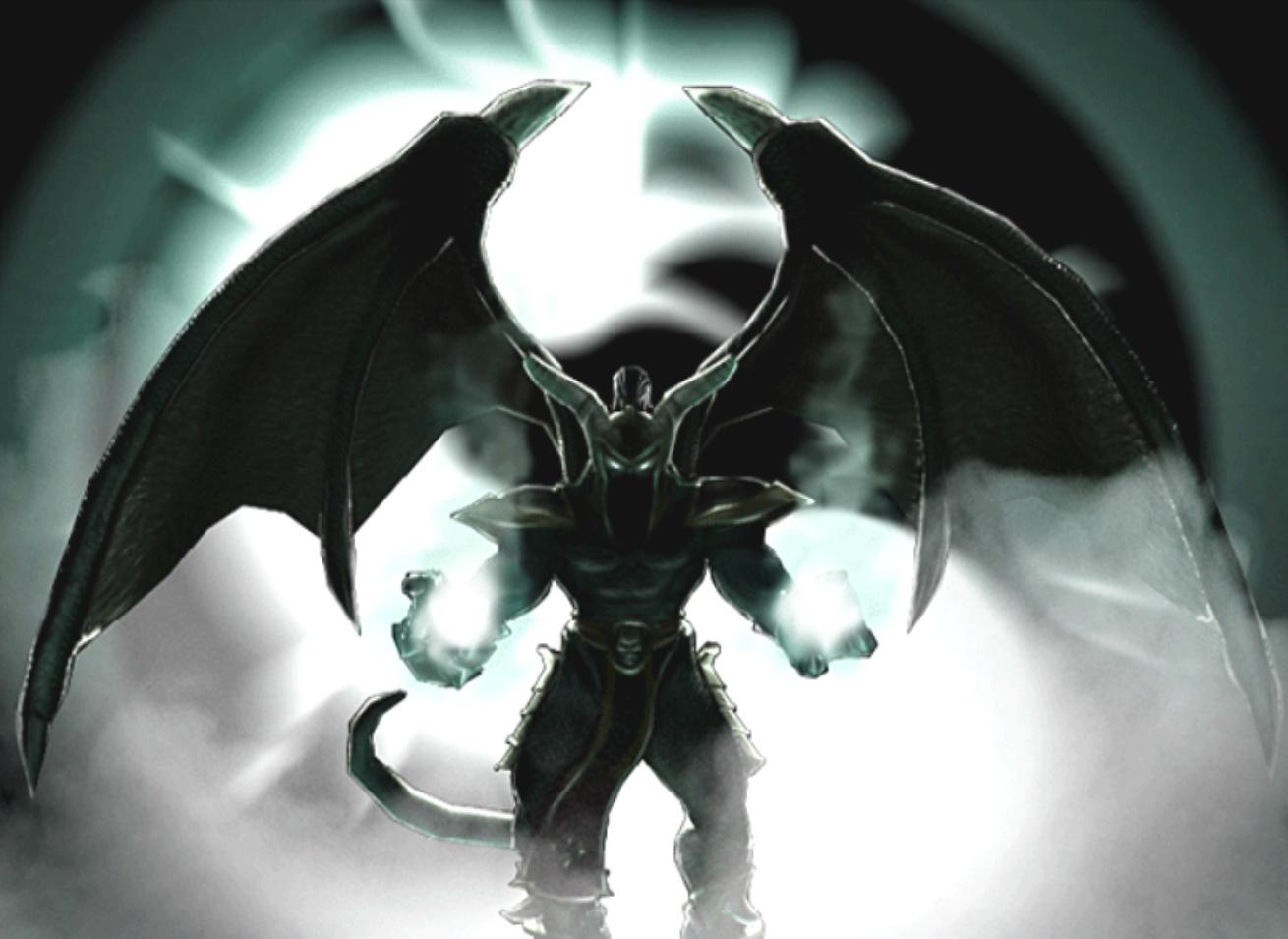


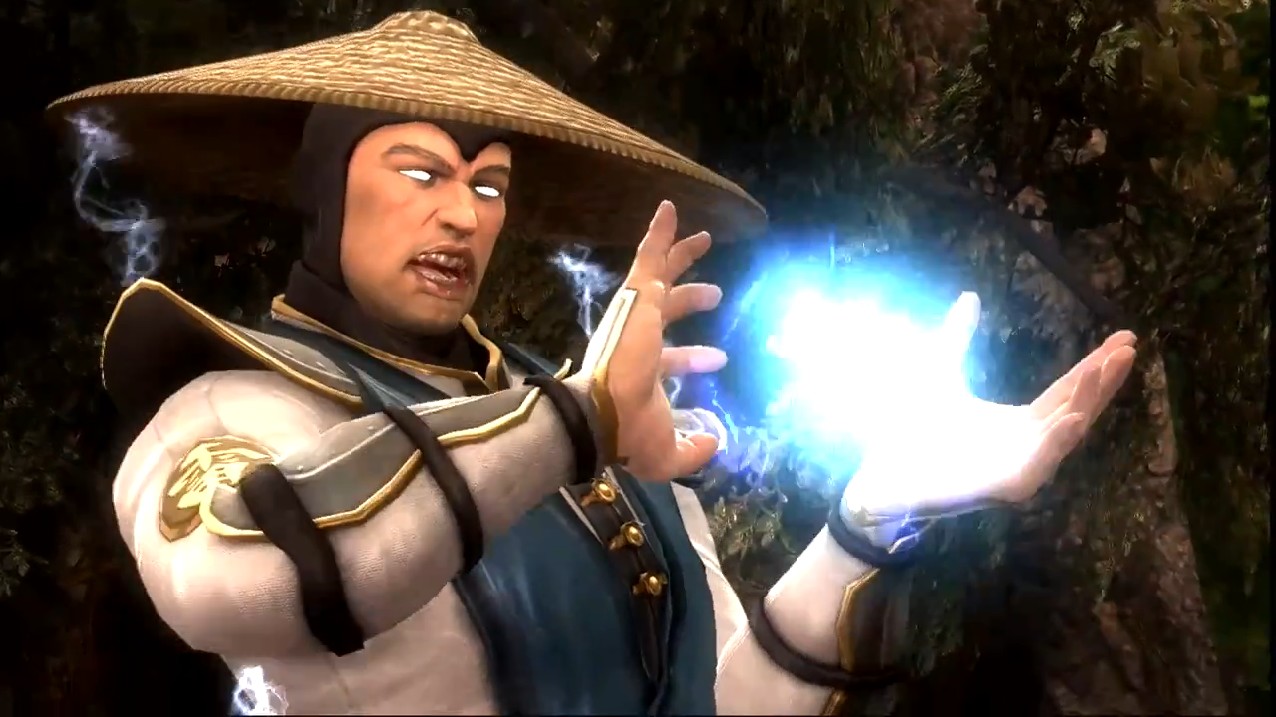


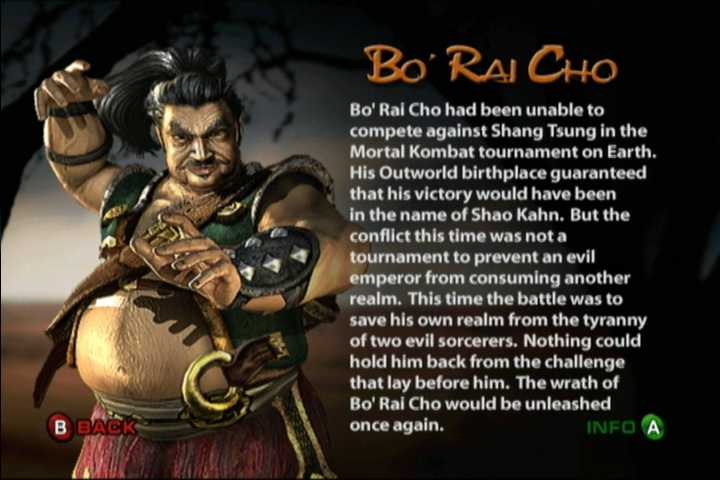
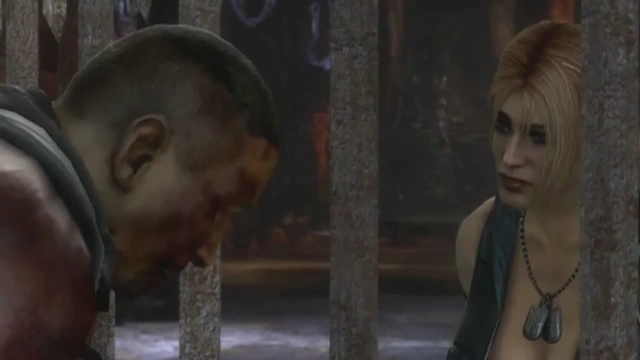


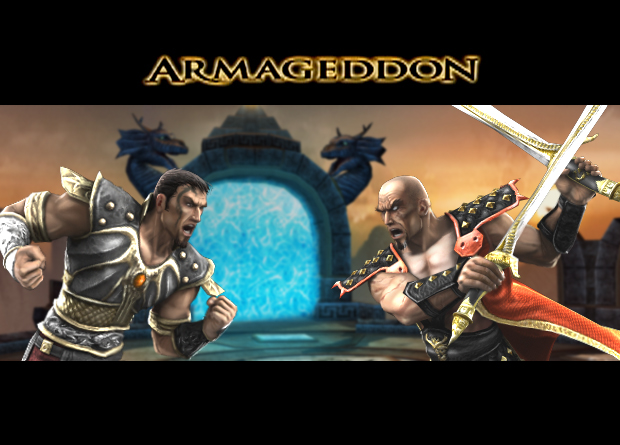
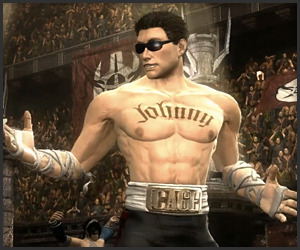

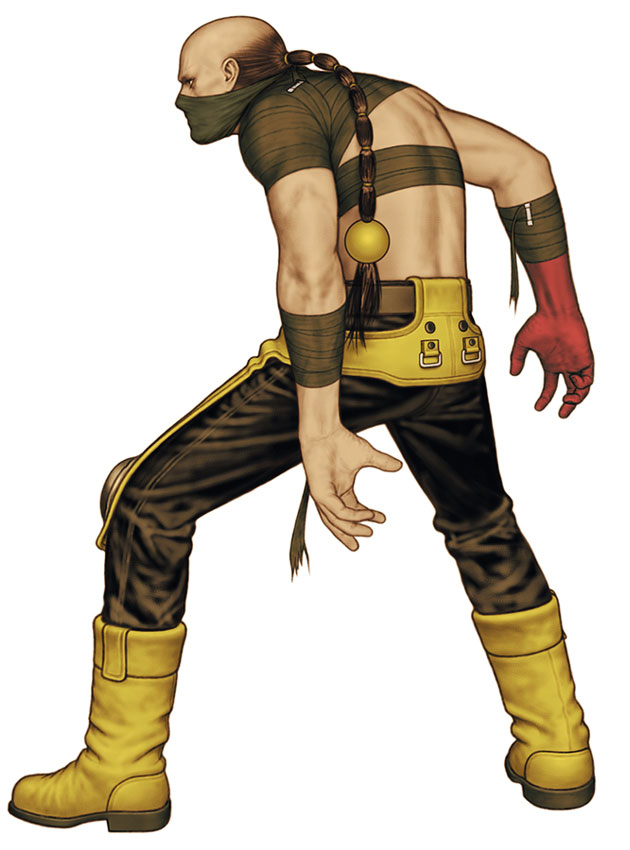
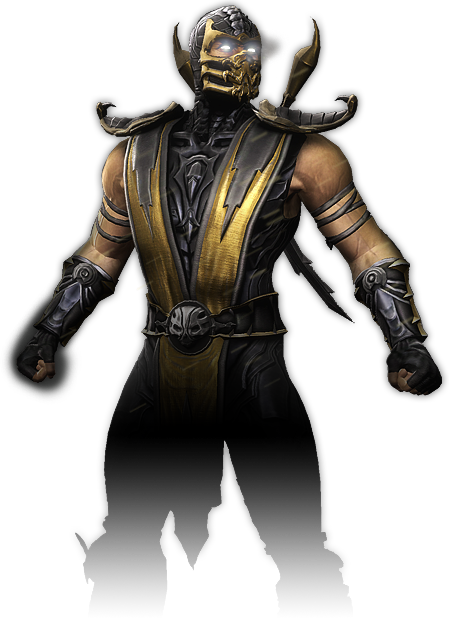


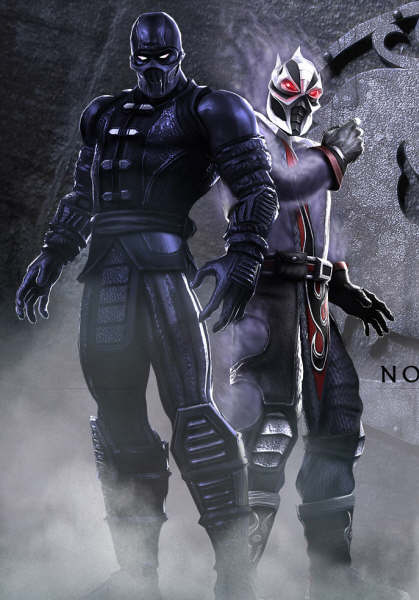


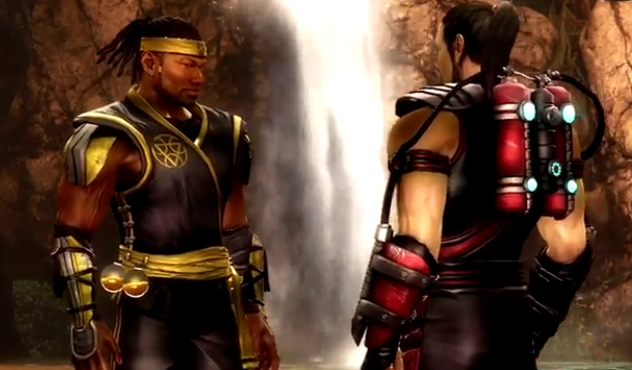
No comments:
Post a Comment